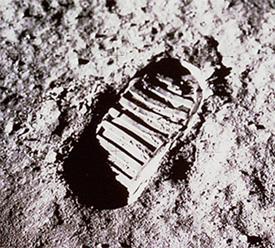First-Hand:Background of how I became involved in the Saturn-Apollo Lunar Landing Program

Submitted by Walker H. Land
I am writing this summary of how I became involved in the Lunar landing program at the request of my son Haden, his wife Cathy, and Dr. Schaffer, with whom I am currently writing a book on Machine Intelligence (MI) to be published by Springer in 2019.
The year was 1964, and I was finishing my graduate work at George Washington (GW) Univ. in Washington, DC. My thesis was on the subject of flight trajectory optimization using the calculus of variations, subject to the numerical optimization of the non-linear two-point boundary problem. [advisor: Dr. Crafton and he was in the dept of Engineering] After my thesis defense (my admission comprehensive exams were waived (lucky me)), I had an interview in Huntsville Al. with IBM (for whom I was working at the time and going to night school) for the purpose of working for NASA, with whom IBM had a contract for the Instrument Unit, which was part of the Saturn rocket assembly, which also contained the guidance and control system for the Saturn rocket system.
My interview lasted for over 3 hours where I was asked many questions on all the topics related to my research at GW. The interview went very well and I received a job offer to show up and soon. Upon my arrival in Huntsville and reporting on my first day of work, I recall very vividly when Mr. Robert (believe that was his first name) Walker came into the room in which I was located and said (I am per paraphrasing) our objective is to put a man on the moon and your job is to tell us how to get there and to get back, and then walked out of the room.
At that time I was 32 years old and had 7 years’ experience and my “professional “experience, related to space work, was restricted to developing technology for the TIROS weather satellite under contract with the Goddard space flight center in Washington, DC. After he left I was sitting there thinking “what have I gotten myself into”, because I knew from my previous research on the subject that getting to the moon and back meant having to “hit” a square foot of space behind the moon when measured in the 6 components of position and velocity (or the six orbital parameters).
I worked on that problem for the next four years, with the help of some other IBMs located in Huntsville and Owego, NY. However, I was in charge of the effort and responsible for it efficacy and accuracy. To make a long story short, I published a paper at the International Astronautical Congress (held in New York City that year) in October 1968. This paper described the lift off, parking orbit, translunar injection translunar and trans earth phases of the mission, which went pretty well as we had predicted as I remember. That same paper was published in Poland (behind the iron curtain) in 1969 unknown to me. I recall, and still have, the letter that the editor of the journal sent me stating that they had not received my corrections on their “proofs” and they were publishing what they had. I told them that I had not responded because I did not know they were publishing the paper.
While working in Huntsville, I was able to transfer to NASA headquarters and was working for Mrs. Ann McNair, who reported the NASA administrators. This was an excellent position, because I could choose my own research projects, subject to her and my IBM supervisors’ approval--- actually her approval only was all that was required. While in that position and working for her, I submitted 10 new technology reports for previous research as well as for research approved by her under NASA’s new technology program. These 10 new technology developments were most new technology received by a single individual at NASA in Huntsville, and I received a new technology achievement award from NASA for the effort.
I will “close out” this summary with a couple of events that happened at the conference in NYC in 1968. The first event occurred during my scheduled research session and before I was to present my research I noticed that a very large man with the largest head I have ever seen was sitting beside me. On a closer inspection, I noticed it was Dr. von Braun, the head of all the NASA programs at Huntsville and the one responsible for the design of the Saturn system. I did not work for or know him, but he was there. Secondly, after the meeting I had people asking me questions about my research, one person in particular with many detailed technical questions. He was hard to understand as his English was poor because, as I ascertained later, he was one of the Soviet’s scientist working on their space program.
There are many more stories I could related, including my recent conversation with Katherine Johnson, who was a pioneer on the Mercury, Gemini and Apollo programs. But I will stop here.
Further Reading
Land, Walter H., "Network Support Simulation and Sensitivities Analysis for the Saturn-Apollo Missions," J. Spacecraft, Vol 7, no 8, August 1970